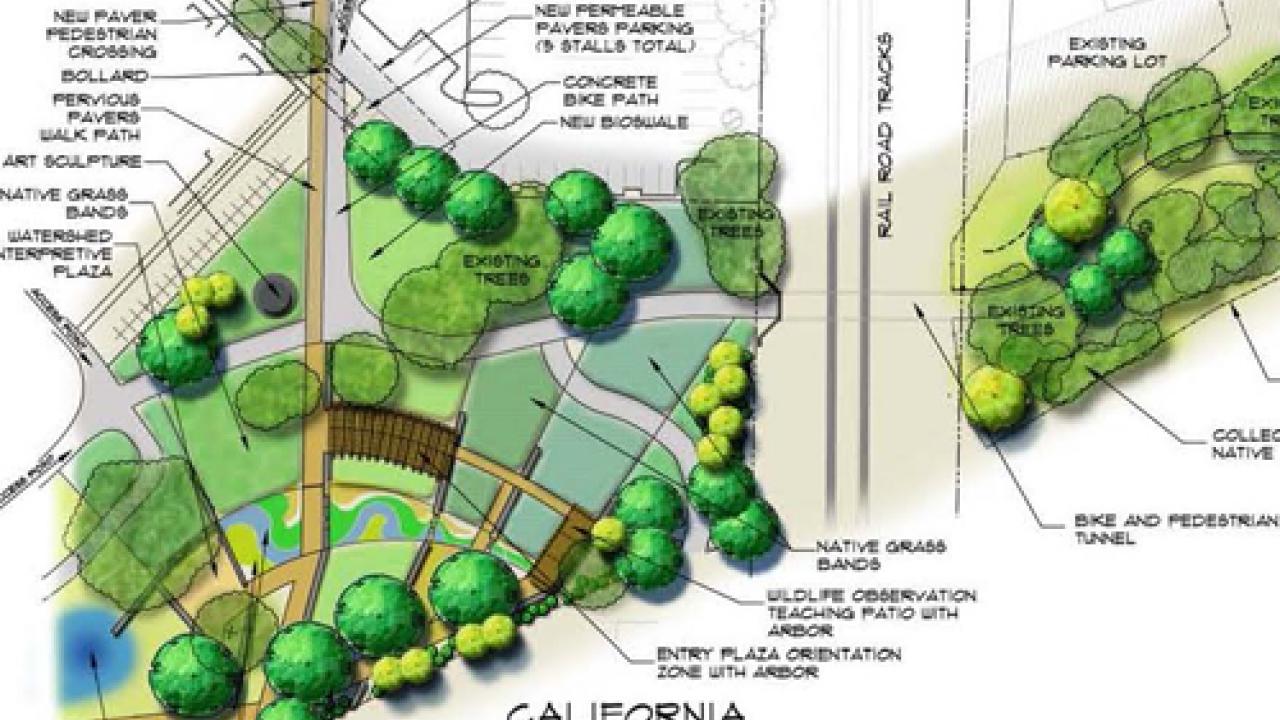
City of Davis and UC Davis Arboretum partner on greening project
(Content from City of Davis and UC Davis Arboretum joint press release.)
The City of Davis, the UC Davis Arboretum, and a number of partners have recently been awarded a grant of $891,304 from the California Strategic Growth Council for the Downtown Davis Parkway Greening Project. The 5-acre project area includes 3.5 acres along the Putah Creek Parkway, where a bike path west of Olive Drive connects the bike tunnel under I-80 with the bike tunnel under the railroad tracks. This greenbelt follows the remnant north fork channel of Putah Creek which will be restored with native plantings as a unique natural habitat area near downtown. The project also includes 1.5 acres at the east end of the Arboretum near Aggie Village and the Davis Commons shopping center. This will be the site of a new California native plant garden focused on plants native to the Putah Creek watershed. The project will also fund the reconfiguration of bike and pedestrian paths to improve access and circulation and the installation of bio-swales and pervious concrete to capture parking lot storm water run-off.
Most of the construction for the project will occur this summer with planting following this fall. By spring of 2016 – the grant deadline for project completion – the new plantings will be well-established and installation of signage will be complete.
The project is the result of an innovative collaboration among the City of Davis, UC Davis Arboretum, UC Davis Administrative and Resource Management Division, Yolo County Resource Conservation District, TreeDavis, Putah Creek Council, Fulcrum Capital, Cunningham Engineering, and private landowners to create a vibrant green space and a dynamic educational resource that will serve as a model for communities throughout California. The ultimate success of the project will depend on community support, both upfront during the design process and in the long run through volunteerism and donations.
According to Joe Krovoza, mayor of Davis, “The Strategic Growth Council’s funding of this project is a testament to what can happen when diverse governmental agencies, non-profits, and private companies collaborate to improve our community. This project will become the heart of where the City intersects with the UC Davis Arboretum. The fusion of city greenbelts with the Arboretum will become a phenomenal example of bicycle and pedestrian corridors, drawing users for commuting, recreation, education, and the arts.”
The project site is strategically located at a hub of bicycle and pedestrian circulation where routes to the Arboretum, downtown Davis, the UC Davis campus, and South Davis intersect. The project will include several major elements:
The Putah Creek Parkway is a key bikeway linking South Davis with the UC Davis campus and downtown Davis. The project will improve wildlife habitat by removing invasive, non-native plants and trees; removing trash and rubble from the site; planting native riparian plants; and installing nesting structures for native pollinators. Interpretive signs will identify native plants and their habitat value and explain the history of the site. New pedestrian trails and benches will provide better access and comfort for visitors.
A California Native Plant Garden will be an inviting space and major entry into the Arboretum from downtown. Teaching patios with themed plantings and interpretive signs will educate visitors about the regional flora and fauna, the history of the Putah Creek watershed and its current management, and how to create sustainable landscapes with native plants. A sculptural gateway element, funded by the City of Davis Municipal Arts Fund, will mark entry to the project site from downtown. Lighting along the garden’s major circulation corridor will improve user safety.
According to Assistant Vice Chancellor and Arboretum Director Kathleen Socolofsky, this grant “presents a great opportunity to share the wealth of the Arboretum’s innovative gardens and programs with more people in the community. This project reflects our vision for the City Arts GATEway, the section of the Arboretum that intersects with downtown Davis, as part of the UC Davis GATEways Project (Gardens, Arts, and The Environment).”
The project will also implement green parking lot retrofits to demonstrate best practices in storm water infiltration and treatment. The garden site abuts a parking lot that serves the Davis Commons retail center. Parking lot runoff will be diverted into a “rain garden” biofiltration feature. In several parking stalls near the garden entry, asphalt will be replaced with a pervious, more reflective surface to help reduce urban heating. Interpretive signs will inform visitors about the use of pervious surfaces and vegetation to reduce and filter surface runoff.
Circulation improvements will ensure safe access to the Arboretum and the Putah Creek Parkway for bicycles and pedestrians. Improvements will include realigning pedestrian and bike paths and installing wayfinding signage, to create a visible and accessible connection from the Arboretum to downtown Davis and the city-wide bicycle circulation system.
Funding for the project comes from voter-approved Proposition 84 (the Safe Drinking Water, Water Quality and Supply, Flood Control, River and Coastal Protection Bond Act of 2006), which included $90 million for urban greening projects. In the second round of funding, the agency received 261 project concepts requesting $232 million; 54 applicants for large projects were invited to submit full proposals. Of these, 24 were funded, for a total of $15,337,825. The Davis project was ranked #1 in a tie with two other proposals out of the 24 large projects funded. The California Native Plant Garden is partially funded by grants from the Institute of Museum and Library Services, the Stanley Smith Horticultural Trust, the Stuart Foundation, the Thornton S. and Katrina D. Glide Foundation, and the Rotary Club of Davis, and by the UC Davis office of Campus Planning and Community Resources.
